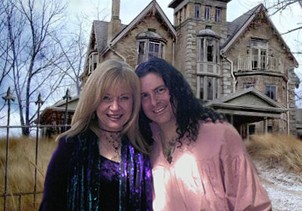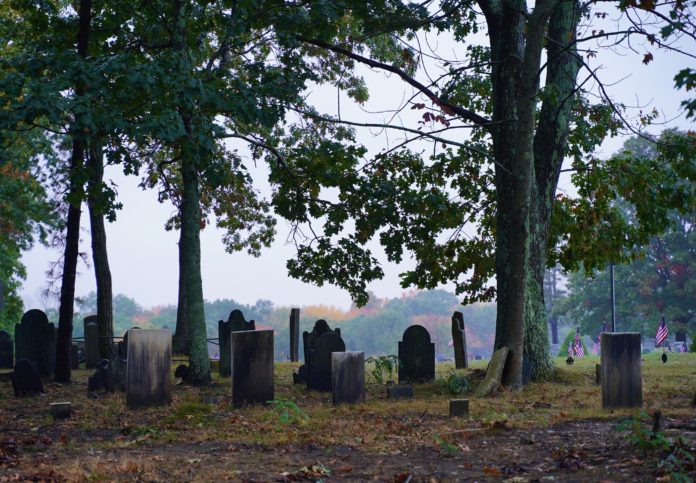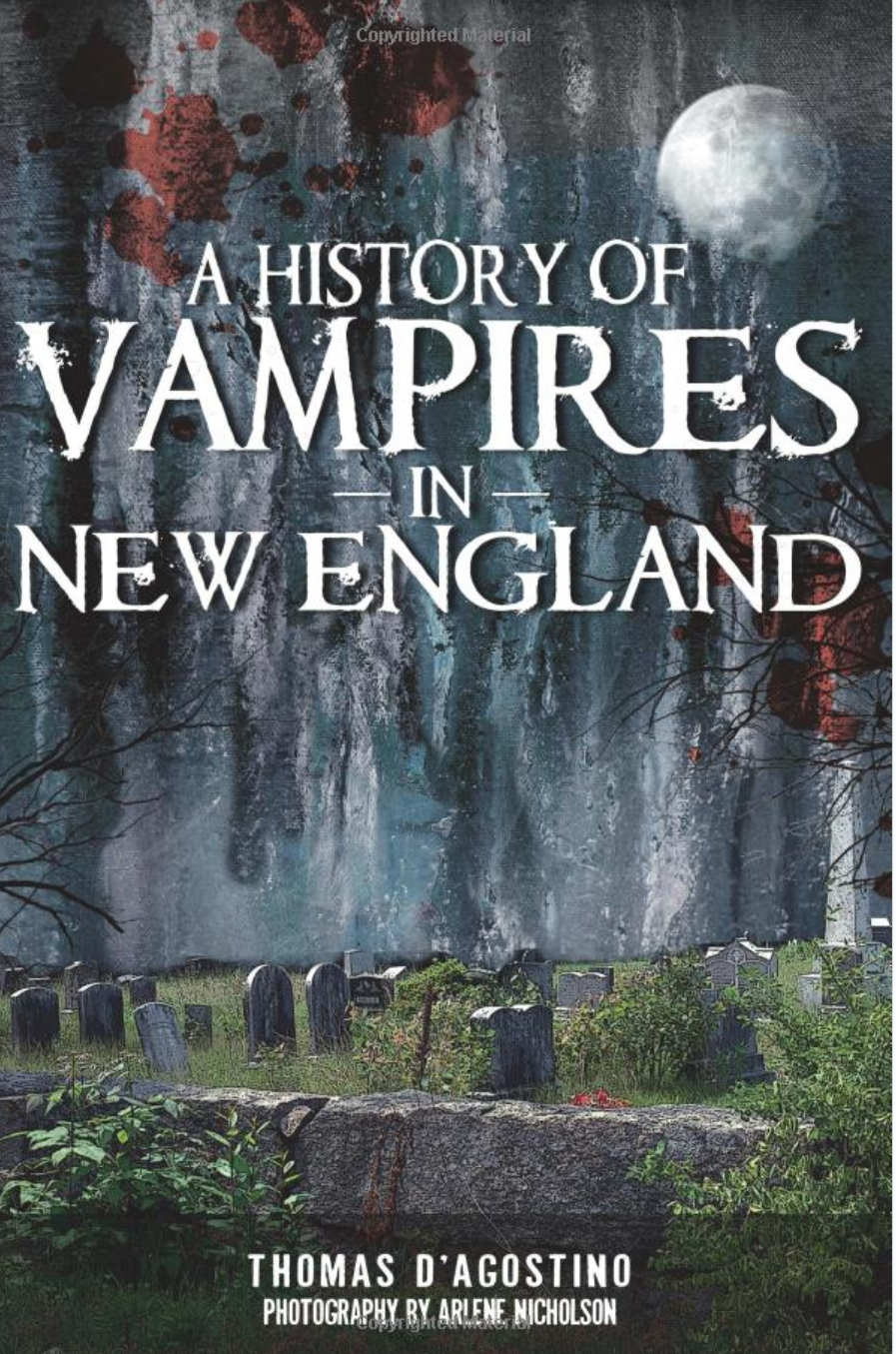NORTH SMITHFIELD – The epitaph is inscribed on an old grave: “Altho’ consumption’s vampire grasp had seized thy mortal frame, thy ardent and inspiring mind, untouched, remained the same.”
Speculators suggest “vampire” is possibly a figure of speech for the condition of consumption. But some the more imaginative contend that the grave of Simon Whipple Aldrich, in a North Smithfield cemetery, is that of a vampire.
Talk of bloodsuckers was in vogue in the 19th century, just as today the macabre is trending on social media with the vampirish discussion of adrenochrome, a chemical the body produces under extreme stress. In September 2020, a guest on the popular syndicated TV series Dr. Phil contended that her daughter Jessie Grace was killed to extract adrenochrome from her body.
Far from the TV screen, under a gloomy October sky in North Smithfield, leaves are falling to their resting place surrounding old gravestones, including several that are cracked or broken. The Union Cemetery Annex, final resting place of Simon Whipple Aldrich, seems the apt location for a vampire legend to arise.
Born in 1814 to a prominent Rhode Island family, Aldrich’s father Colonel or Captain Dexter Aldrich was a banker who owned a farm in Smithfield.
Aldrich’s mother was Margery (Smith) Aldrich, whose family came to Massachusetts in 1630. His brother Cyrus Aldrich is remembered as popular Congressional representative from Minnesota, and a friend of Abraham Lincoln’s.
Aldrich seems to have served his country in the military as an ensign. He died in 1841 at age 26 or 27.
The epitaph on his headstone might imply Aldrich died from consumption, today known as tuberculosis. Consumption in the 1800s cut short the life of many, including legendary American writers Washington Irving, Henry David Thoreau and Charles Brockden Brown.
The sickness also had a strange effect on society.
“The flushed cheeks, the bright eyes, fever, loss of appetite, and most of all, the cough. It was feared, but regarded with a peculiar resignation because it was so unavoidable,” wrote Constance Manoli-Skocay in an online essay “A Gentle Death: Tuberculosis in 19th Century Concord.”
“It was dreaded, but at the same time romanticized. It was a disease that reflected the culture of its time: the victim slowly, gracefully fading away, transcending their corporeal body, their immortal soul shining through.”
“The white death,” as the consumption was known during the Romantic era, “was seen as a sign of sensitivity, spiritual purity and temporal wealth,” according to Lord Byron, the great English poet of immense influence.
Byron, in 1813, penned a poem about a vampire dubbed The Giaour:
But first, on earth as Vampire sent,
The corse shall from its tomb be rent;
Then ghastly haunt they native place,
And suck the blood of all thy race,
There from thy daughter, sister, wife.
At midnight drain the stream of life;
Yet loathe the banquet which perforce
Must feed they livid living corpse;
Thy victims ere they yet expire
Shall know the daemon for their sire.
“Young ladies begun purposefully paling their skin in order to achieve the consumptive appearance and they also dropped belladonna into their eyes for it dilated their pupils, giving the eyes luminous glow,” explained a blogger going by the name “byronsmuse.”
The romanticized epitaph on Simon Whipple Aldrich’s North Smithfield grave is from an 1838 poem by Eliza Earle, a poet, educator, and abolitionist from Massachusetts whose poems were published in William Lloyd Garrison’s radical abolitionist newspaper The Liberator.
What might impel the imagination to perceive the inscription headstone as warning to the living is part of the poem is not visible.
“The stone broke or cracked [so someone] cemented over some of the epitaph,” said educator and author Thomas D’Agostino a leading expert on the supernatural and history.
D’Agostino lived in Burrillville for several years. He and his wife Arlene Nicholson are authors of thirteen books including, “A History of Vampires in New England.”
Obscuring some of the inscription on the stone makes the curious and imaginative wonder. Perhaps the word “resurrect,” was written there, not unusual among the religious in those days, said D’Agostino.
Simon Whipple Aldrich, “died at a relatively young age,” D’Agostino explained. “His sisters died before and after him. Several children died at a fairly young age of consumption. The idea of the consumption and the vampire had taken root in New England.”
D’Agostino says there’s no record of an exorcism, a not unusual practice back then.
Tales of the strange in the Ocean State go back to at least the 18th century to the case of alleged vampire Mercy Brown of Exeter.
“Rhode Island is the vampire capital of the world,” said D’Agostino, naming a few: “Nancy Young, Mercy Brown, the Staples case, Simon Whipple Aldrich, the Tillinghast cases and Nancy Young.”
Young lived at the Foster and Connecticut line. In 1827 after Almira, Nancy’s sister, fell ill, the body of the deceased Nancy was burned on a pyre and the smoke was inhaled as a curative.

D’Agostino also explains that the said cure to stop a suspected vampire and make the stricken victim well was, “dig up the deceased…remove the heart, liver, and lungs. Burn to ashes. Feed the ashes to the sick.”
“There’s more. These cases are actually documented,” D’Agostino said.
Stories of vampires in Connecticut and Vermont are connected to people who moved there from Rhode Island.
In contrast to the cases of the women, Simon Whipple Aldrich’s association with vampirism is based on the headstone.
In the past human bloodsuckers were known as, “spectral ghouls”- night visitors, “feeding on the body,” said D’Agostino. The term “vampire” was used in The Hartford Courant newspaper as early as 1765 and was published in the Oxford Dictionary in 1734.
What’s more, Voltaire, the famous French writer, described vampires, said D’Agostino.
“These vampires were corpses, who went out of their graves at night to suck the blood of the living, either at their throats or stomachs, after which they returned to their cemeteries,” states Voltaire’s 1764 Philosophical Dictionary. “The persons so sucked waned, grew pale, and fell into consumption; while the sucking corpses grew fat, got rosy, and enjoyed an excellent appetite. It was in Poland, Hungary, Silesia, Moravia, Austria, and Lorraine, that the dead made this good cheer.”
Looking into history, one finds plenty more about the undead.
Cumberland’s British Theater, an 1827 book of plays has some explanation of the powers of the fabled vampire, such as how the creatures escape the grave.
“The Pictorial National Library (1848) states the word ‘vampire’ is of Servian origin, and the living dead were known of in such places as Crete, Greece, and in Hungary where it was believed the dead rise, drink the blood of the living, and then victims fall into consumption and die,” it states.
A short story “Portfolio” published in 1830 with no named author describes a vampire as, “a man enveloped in his shroud, pale and ghastly, enter by the window, that he sprung upon her, bit, and almost stifled her.”
Rhode Island is notorious for vampires; yet it is not New England, not Transylvania, nor London of the 19th century that is the source of one of the earliest tales of the vampire, but ancient times, during the reign of Phillip II of Macedon 359-336 BC.
It seems in the year Two, one Phlegon of Tralles tells a tale set during Phillip’s reign of the unexpected death of the bride of a General Craterus. Months after her untimely death, the bride, now a vampire, appears to the general with her new man – another vampire. The parents of the deceased bride believe an impostor is impersonating their daughter – until they discover the bride’s tomb is empty.
While the truth behind the mysterious inscription on Aldrich’s grave may never be fully known, such tales of the undead will continue to scare and inspire many who pass.








